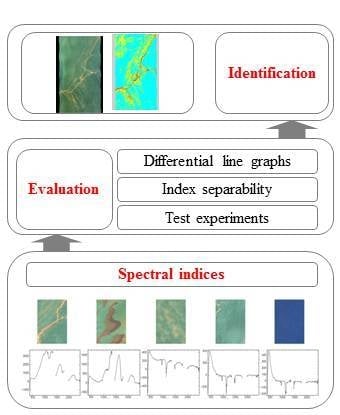Evaluation of the Ability of Spectral Indices of Hydrocarbons and Seawater for Identifying Oil Slicks Utilizing Hyperspectral Images
Abstract
:1. Introduction
2. Materials and Methods
2.1. Study Area
2.2. Data Preprocessing
2.3. Oil Slick Properties
2.4. Spectral Indices of Hydrocarbons and Seawater
2.5. Evaluation Measurement
- Differential line graphs based on the training samples.
- The proposed IS measurement.
- Test experiments.
2.6. Experimental Process
3. Results
3.1. Evaluation Results
- The values of , , and are larger than zero, which means that FI, RR (hydrocarbons), and CDOM can be used to distinguish emulsions from seawater and other oil slicks. The “*” means the other categories of the element set {seawater, sheens, oil slicks of code 4, oil slicks of code 5, emulsions}.
- The values of , , and are larger than zero, which means that FI, RR, and CHL may be able to distinguish seawater from oil-contaminated areas. Although the values of are nonzero, is 0.0043 which is too close to zero, so CDOM was not considered during test experiments.
- RR is the only spectral characteristic for which all the non-diagonal elements larger than zero, which means that RR may be able to identify seawater and all thicknesses of oil slicks.
- There is an obvious complementarity of spectral indices of hydrocarbon substance and spectral indices of seawater.
3.2. Identification Results
3.2.1. Results of Detecting Emulsions
3.2.2. Results of Detecting Sheens
3.2.3. Detection of Oil Slicks by Hydrocarbons (RR)
- In the differential line graph of RR (Figure 7), the ranges of sheens and continuous true color oil slicks are small, making it very likely that RR will misidentify sheens and oil slicks of code 5.
- In the spectral curves of seawater and oil slicks in red bands (Figure 13), the curves of sheens and oil slicks of code 5 are nearly coincident, indicating that it is not possible to distinguish sheens and continuous true color oil slicks using RR. In addition, it is difficult for RR to distinguish oil slicks of code 5 from oil slicks of code 4 and sheens according to the spectral analysis.
- In the IS matrix of RR, the IS values of oil slicks of code 5 and sheens are 0.005, which is too close to 0 meaning that RR cannot reliably distinguish between oil slicks of code 5 and sheens. This result is also consistent with the actual recognition results.
3.2.4. Detection of Oil Slicks by Complementary Spectral Indices
4. Discussion
4.1. Applicability of Hydrocarbon Spectral Indices
4.2. Applicability of Seawater Spectral Indices
4.3. Complementarity
4.4. Accuracy and Applicability
- (1)
- The experimental AVIRIS image was captured at UTC 20:46 17 May 2010, which was later than the MODIS image (UTC 16:40 May 17) and earlier than the ASAR image (UTC 03:48 May 18). The oil slicks in the earlier captured MODIS image do not reach the boundary identified by AVIRIS, but the oil slicks in the later captured ASAR image cover the identified boundary, which means oil slicks drifted during the interval time.
- (2)
- Sheens at the boundary between oil slicks and seawater cannot be observed from the MODIS and ASAR backscattering images.
5. Conclusions
Acknowledgments
Author Contributions
Conflicts of Interest
References
- Alloy, M.; Baxter, D.; Stieglitz, J.; Mager, E.; Hoenig, R.; Benetti, D.; Grosell, M.; Oris, J.; Roberts, A. Ultraviolet radiation enhances the toxicity of Deepwater Horizon oil to mahi-mahi (Coryphaena hippurus) embryos. Environ. Sci. Technol. 2016, 50, 2011–2017. [Google Scholar] [CrossRef] [PubMed]
- Esbaugh, A.J.; Mager, E.M.; Stieglitz, J.D.; Hoenig, R.; Brown, T.L.; French, B.L.; Linbo, T.L.; Lay, C.; Forth, H.; Scholz, N.L. The effects of weathering and chemical dispersion on Deepwater Horizon crude oil toxicity to mahi-mahi (Coryphaena hippurus) early life stages. Sci. Total Environ. 2016, 543, 644–651. [Google Scholar] [CrossRef] [PubMed]
- Kokaly, R.F.; Couvillion, B.R.; Holloway, J.A.M.; Roberts, D.A.; Ustin, S.L.; Peterson, S.H.; Khanna, S.; Piazza, S.C. Spectroscopic remote sensing of the distribution and persistence of oil from the Deepwater Horizon spill in Barataria Bay marshes. Remote Sens. Environ. 2013, 129, 210–230. [Google Scholar] [CrossRef]
- Lammoglia, T.; de Souza Filho, C.R. Chronology and backtracking of oil slick trajectory to source in offshore environments using ultraspectral to multispectral remotely sensed data. Int. J. Appl. Earth Obs. Geoinf. 2015, 39, 113–119. [Google Scholar] [CrossRef]
- Robla, S.; Sarabia, E.G.; Llata, J.R.; Torre-Ferrero, C.; Pérez Oria, J. An approach for detecting and tracking oil slicks on satellite images. In Proceedings of the OCEANS 2010 MTS/IEEE, Seattle, WA, USA, 20–23 September 2010. [Google Scholar]
- Clark, R.N.; Swayze, G.A.; Leifer, I.; Livo, K.E.; Kokaly, R.; Hoefen, T.; Lundeen, S.; Eastwood, M.; Green, R.O.; Pearson, N. A Method for Quantitative Mapping of Thick Oil Spills Using Imaging Spectroscopy; US Geological Survey Open-File Report; US Geological Survey: Reston, VA, USA, 2010; Volume 1167, pp. 1–51.
- Leifer, I.; Lehr, W.J.; Simecek-Beatty, D.; Wozencraft, J.M.; Bradley, E.; Clark, R.N.; Dennison, P.E.; Hu, Y.; Matheson, S.; Jones, C.E. State of the art satellite and airborne marine oil spill remote sensing: Application to the BP Deepwater Horizon oil spill. Remote Sens. Environ. 2012, 124, 185–209. [Google Scholar] [CrossRef]
- Svejkovsky, J.; Hess, M.; Muskat, J.; Nedwed, T.J.; McCall, J.; Garcia, O. Characterization of surface oil thickness distribution patterns observed during the Deepwater Horizon (MC-252) oil spill with aerial and satellite remote sensing. Mar. Pollut. Bull. 2016, 110, 162–176. [Google Scholar] [CrossRef] [PubMed]
- Pisano, A.; Bignami, F.; Santoleri, R. Oil spill detection in glint-contaminated near-infrared MODIS imagery. Remote Sens. 2015, 7, 1112–1134. [Google Scholar] [CrossRef]
- Alam, M.S.; Sidike, P. Trends in oil spill detection via hyperspectral imaging. In Proceedings of the 7th Electrical & Computer Engineering (ICECE), Dhaka, Bangladesh, 20–22 December 2012. [Google Scholar]
- Li, Q.; Lu, L.; Zhang, B.; Tong, Q. Oil Slope Index: An algorithm for crude oil spill detection with imaging spectroscopy. In Proceedings of the 2012 Second International Workshop on Earth Observation and Remote Sensing Applications, Shanghai, China, 8–11 June 2012. [Google Scholar]
- Liu, D.; Zhang, J.; Wang, X. Reference spectral signature selection using density-based cluster for automatic oil spill detection in hyperspectral images. Opt. Express 2016, 24, 7411–7425. [Google Scholar] [CrossRef] [PubMed]
- Kaiser, M.F.; Aziz, A.M.; Ghieth, B.M. Use of remote sensing techniques and aeromagnetic data to study episodic oil seep discharges along the Gulf of Suez in Egypt. Mar. Pollut. Bull. 2013, 72, 80–86. [Google Scholar] [CrossRef] [PubMed]
- Lu, Y.; Zhan, W.; Hu, C. Detecting and quantifying oil slick thickness by thermal remote sensing: A ground-based experiment. Remote Sens. Environ. 2016, 181, 207–217. [Google Scholar] [CrossRef]
- Fingas, M.F.; Brown, C.E. Review of oil spill remote sensing. Spill Sci. Technol. Bull. 1997, 4, 199–208. [Google Scholar] [CrossRef]
- Fingas, M.; Brown, C. Review of oil spill remote sensing. Mar. Pollut. Bull. 2014, 83, 9–23. [Google Scholar] [CrossRef] [PubMed]
- Otremba, Z. The impact on the reflectance in VIS of a type of crude oil film floating on the water surface. Opt. Express 2000, 7, 129–134. [Google Scholar] [CrossRef] [PubMed]
- Mityagina, M.; Lavrova, O. Satellite Survey of Inner Seas: Oil Pollution in the Black and Caspian Seas. Remote Sens. 2016, 8, 875. [Google Scholar] [CrossRef]
- National Aeronautics and Space Administration (NASA). Available online: http://aviris.jpl.nasa.gov/alt_locator (accessed on 5 September 2016).
- Carpenter, A. The Bonn agreement aerial surveillance programme: Trends in North Sea oil pollution 1986–2004. Mar. Pollut. Bull. 2007, 54, 149–163. [Google Scholar] [CrossRef] [PubMed]
- Kumar, A.; Suresh, G. Weathering of Oil Spill: Modeling and Analysis. Aquat. Procedia 2015, 4, 435–442. [Google Scholar]
- Stevens, C.C.; Thibodeaux, L.J.; Overton, E.B.; Valsaraj, K.T.; Nandakumar, K.; Rao, A.; Walker, N.D. Sea surface oil slick light component vaporization and heavy residue sinking: Binary mixture theory and experimental proof of concept. Environ. Eng. Sci. 2015, 32, 694–702. [Google Scholar] [CrossRef]
- Sun, S.; Hu, C.; Feng, L.; Swayze, G.A.; Holmes, J.; Graettinger, G.; MacDonald, I.; Garcia, O.; Leifer, I. Oil slick morphology derived from AVIRIS measurements of the Deepwater Horizon oil spill: Implications for spatial resolution requirements of remote sensors. Mar. Pollut. Bull. 2016, 103, 276–285. [Google Scholar] [CrossRef] [PubMed]
- Cong, L.; Nutter, B.; Liang, D. Estimation of oil thickness and aging from hyperspectral signature. In Proceedings of the Image Analysis and Interpretation (SSIAI), Santa Fe, NM, USA, 22–24 April 2012. [Google Scholar]
- Loos, E.; Brown, L.; Borstad, G.; Mudge, T.; Alvare, M. Characterization of oil slicks at sea using remote sensing techniques. In Proceedings of the OCEANS, Yeosu, Korea, 14–19 October 2012. [Google Scholar]
- Kühn, F.; Oppermann, K.; Hörig, B. Hydrocarbon Index—An algorithm for hyperspectral detection of hydrocarbons. Int. J. Remote Sens. 2004, 25, 2467–2473. [Google Scholar] [CrossRef]
- Sun, P. Study of prediction models for oil thickness based on spectral curve. Spectrosc. Spectr. Anal. 2013, 33, 1881–1885. [Google Scholar]
- Lu, W.Z.; Yuan, H.F.; Xu, G.T. Modern Near Infrared Spectroscopy Analytical Technology; China Petrochemical Press: Beijing, China, 2007. [Google Scholar]
- Hu, C.; Lee, Z.; Franz, B. Chlorophyll aalgorithms for oligotrophic oceans: A novel approach based on three—Band reflectance difference. J. Geophys. Res. Ocean. 2012, 117. [Google Scholar] [CrossRef]
- Kutser, T.; Pierson, D.C.; Kallio, K.Y.; Reinarta, A.; Sobeka, S. Mapping lake CDOM by satellite remote sensing. Remote Sens. Environ. 2005, 94, 535–540. [Google Scholar] [CrossRef]
- Lu, Y.C.; Tian, Q.J.; Qi, X.P.; Wang, J.J.; Wang, X.C. Spectral response analysis of offshore thin oil slicks. Spectrosc. Spectr. Anal. 2009, 29, 986–989. [Google Scholar]
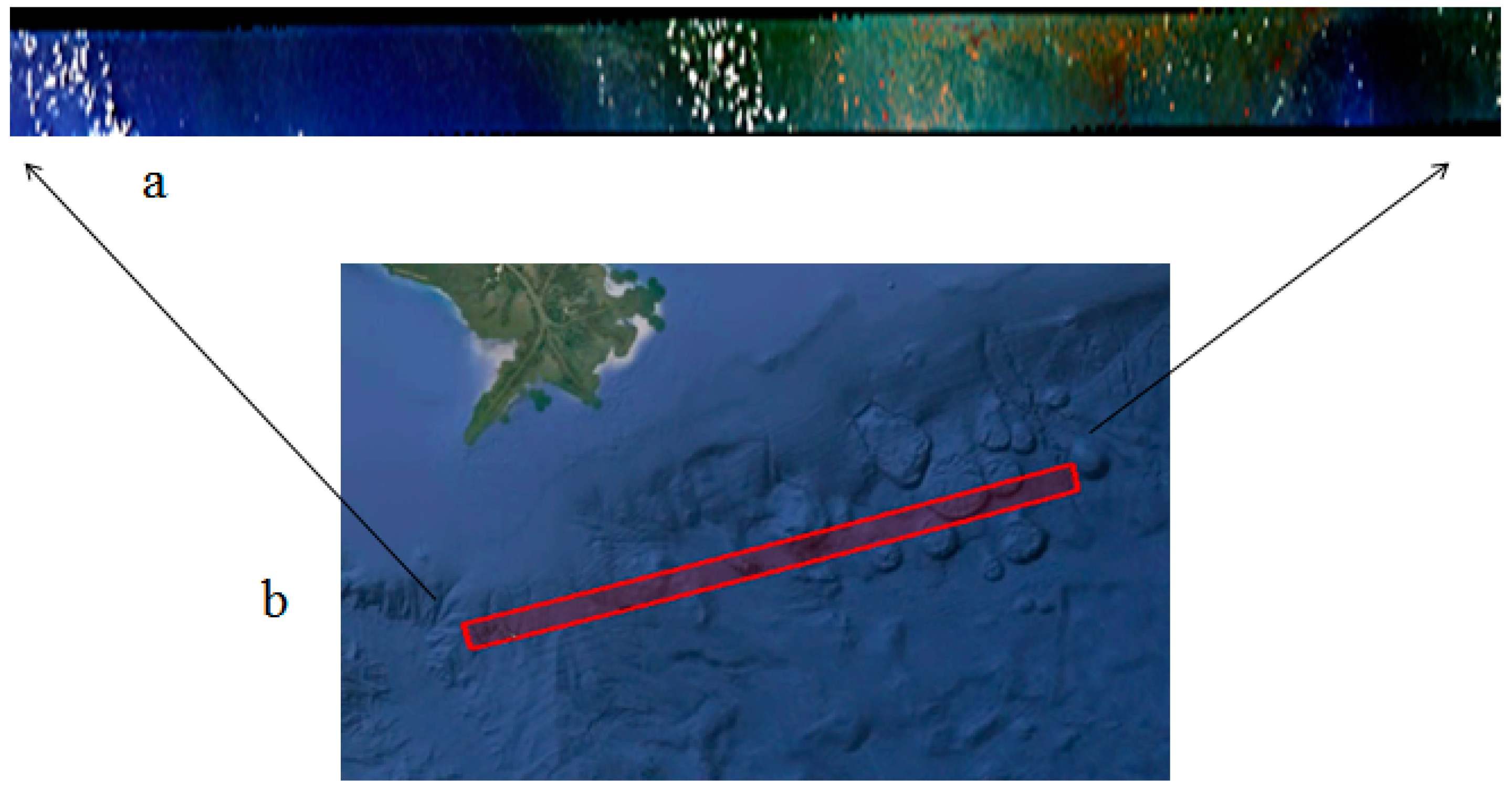
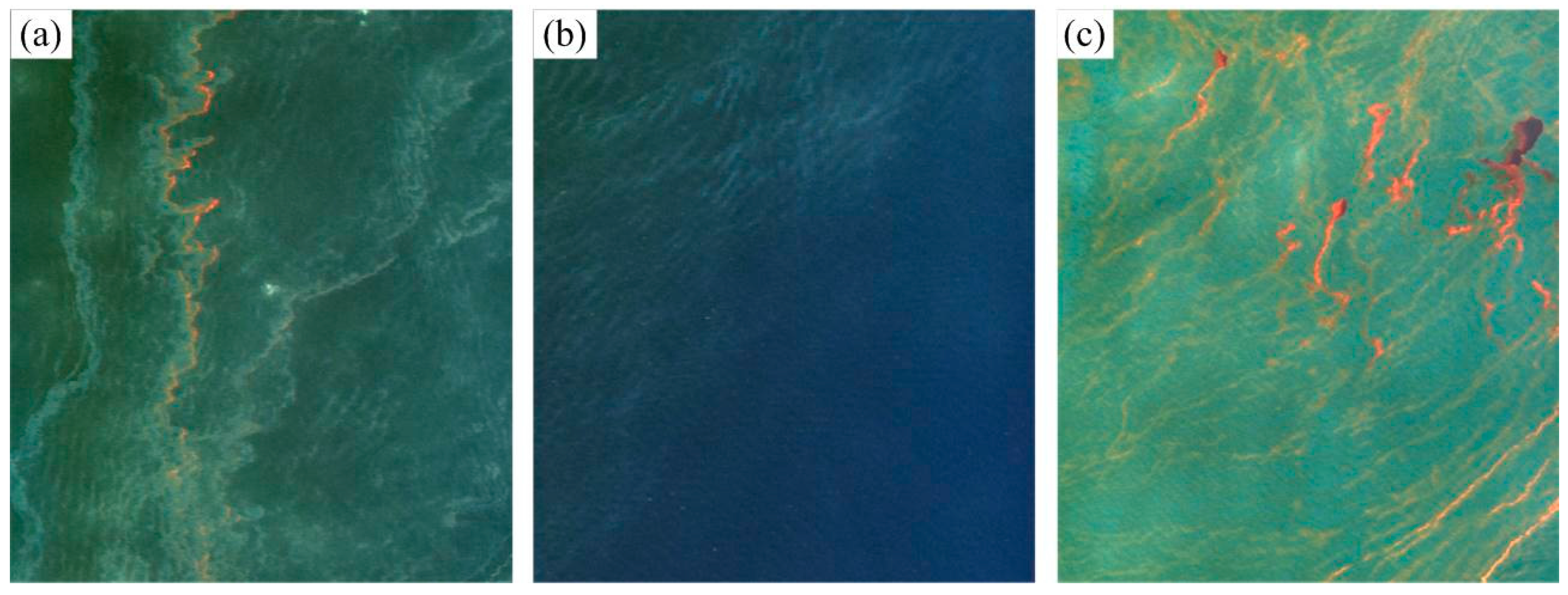
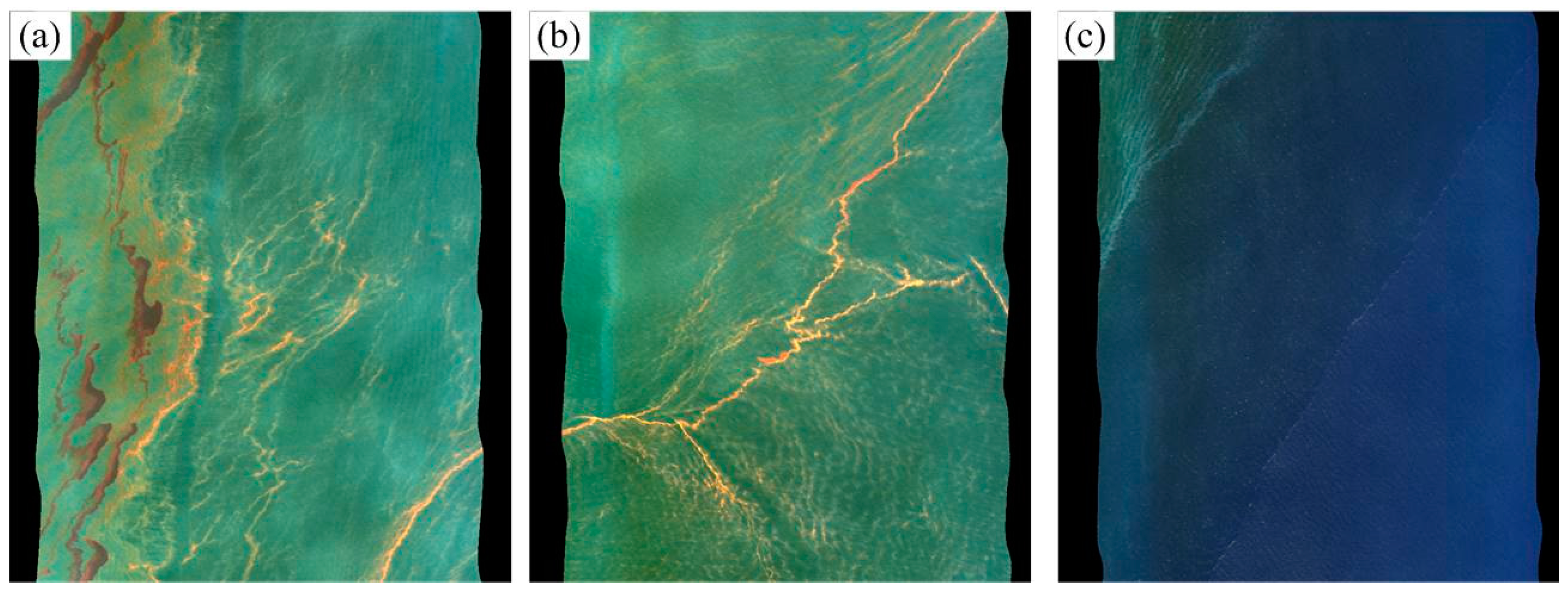
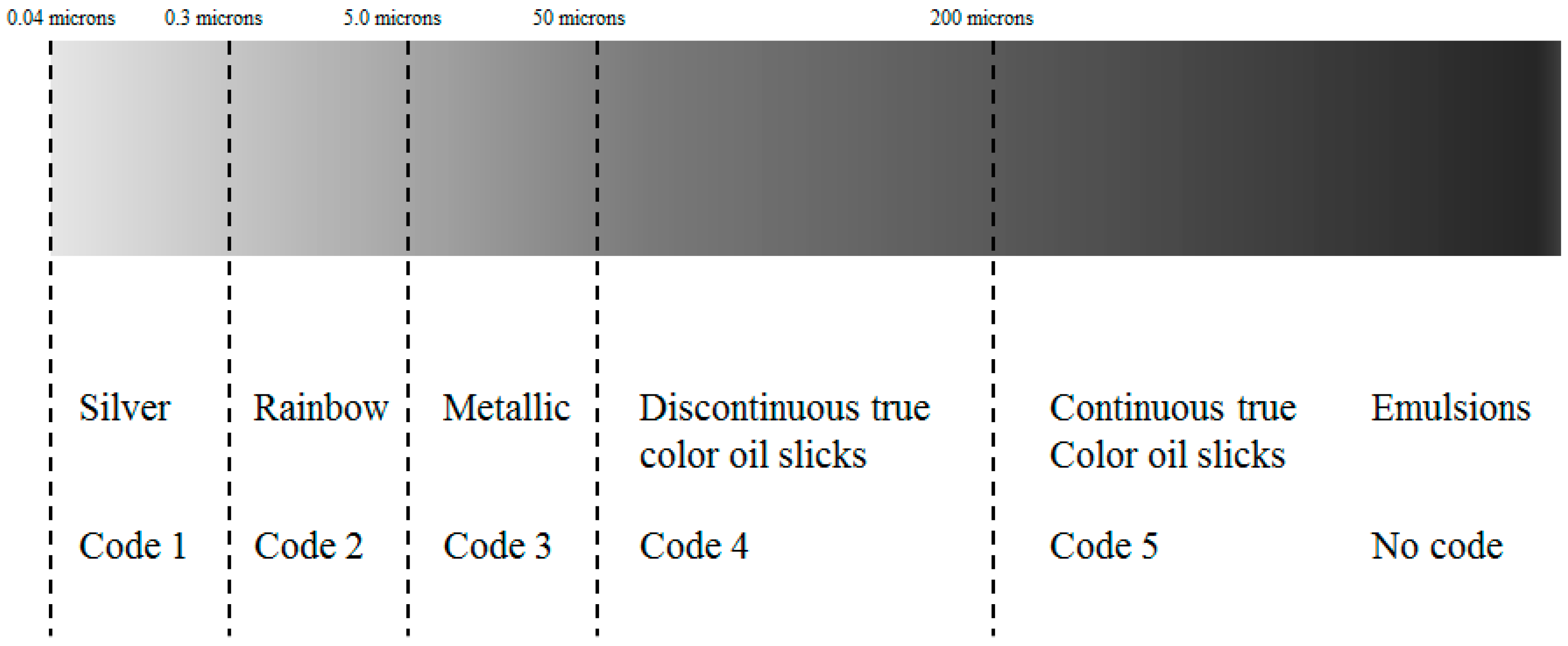



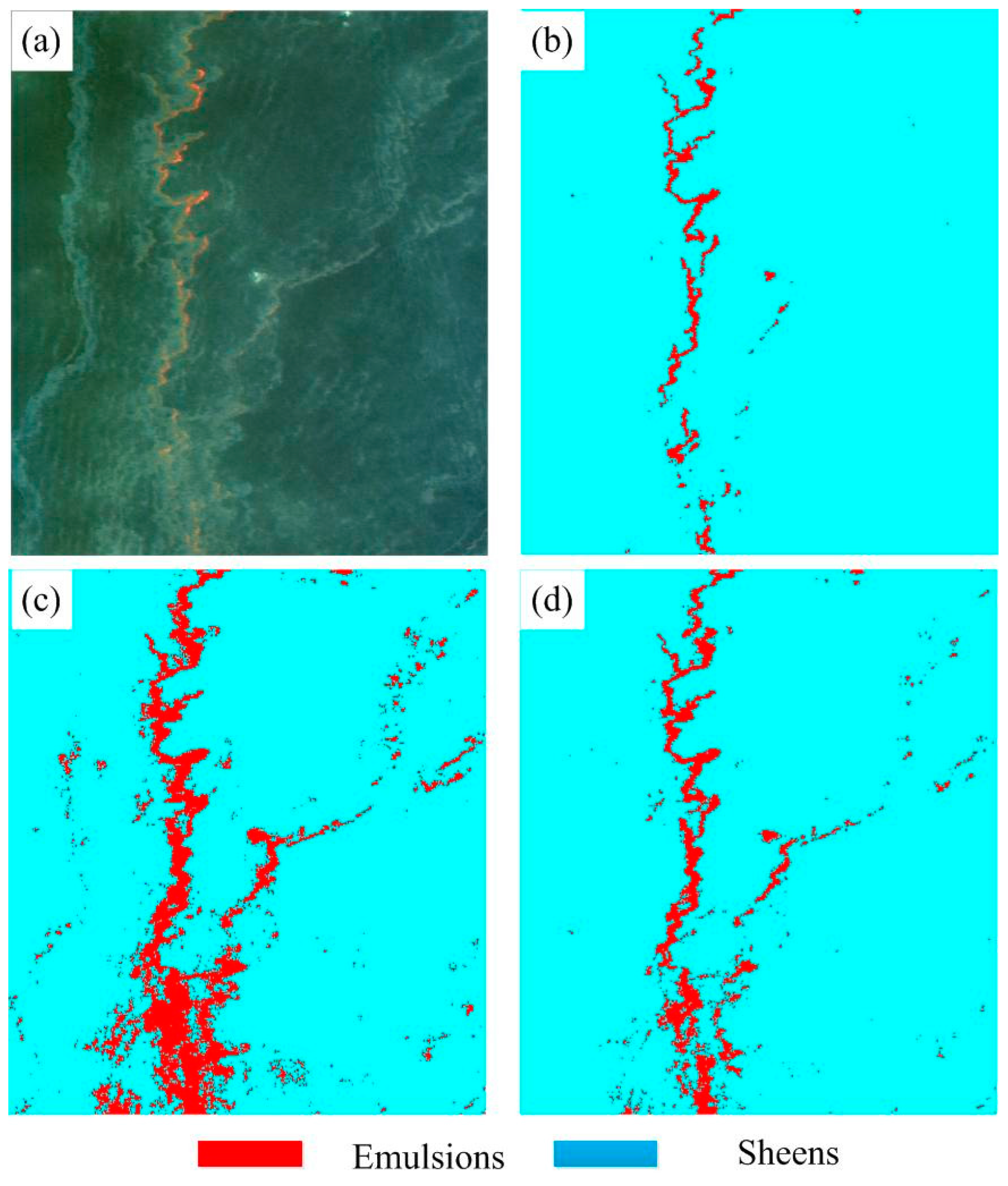
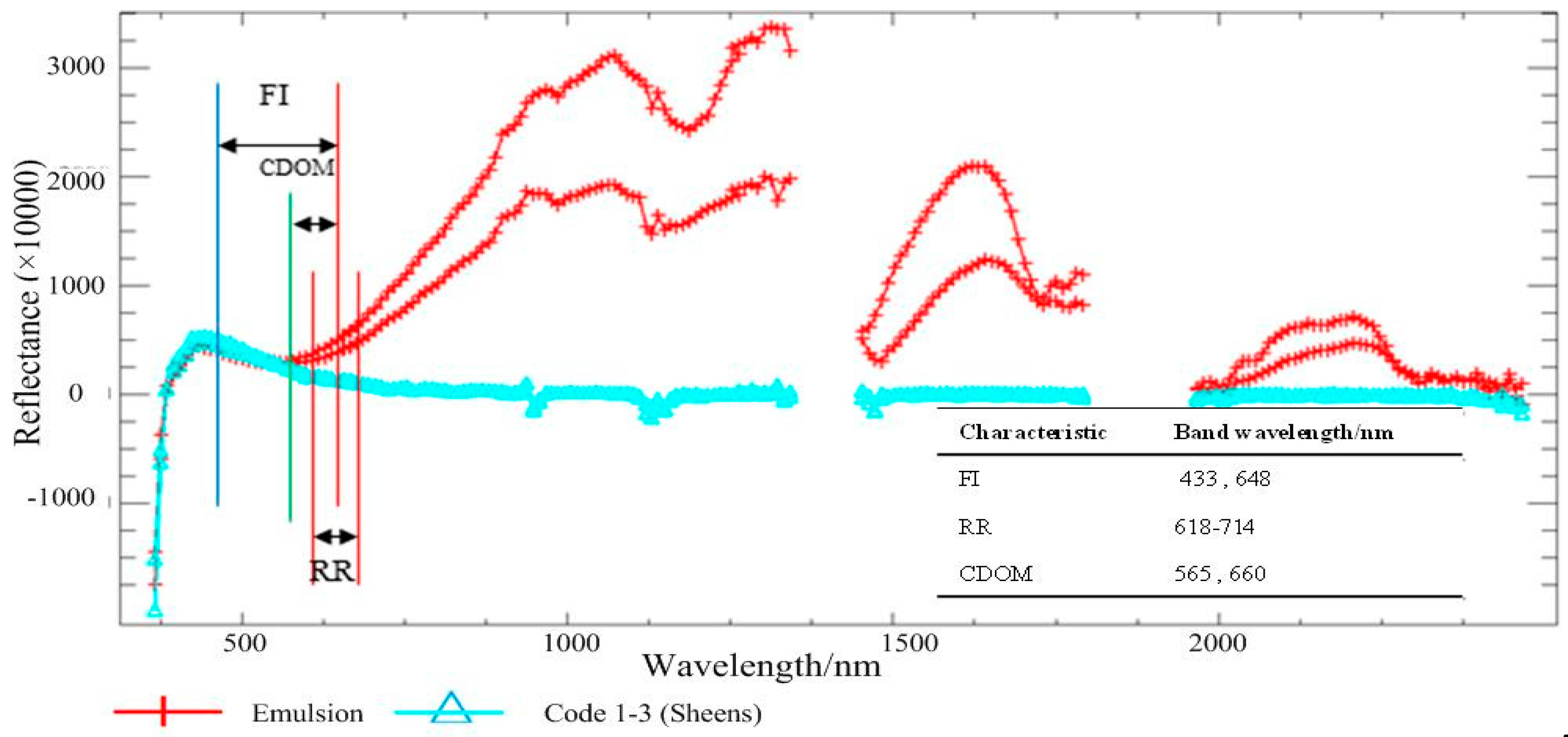
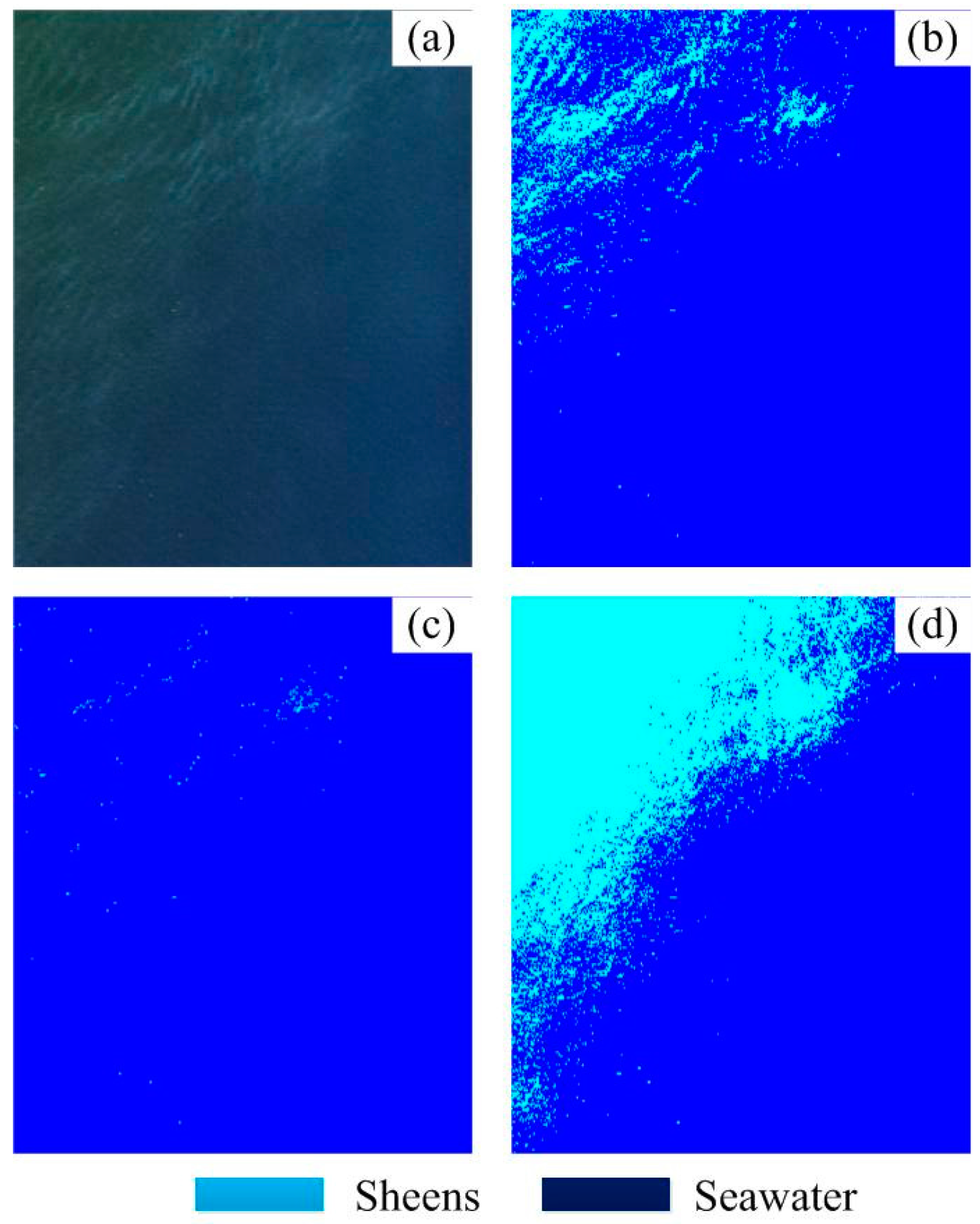
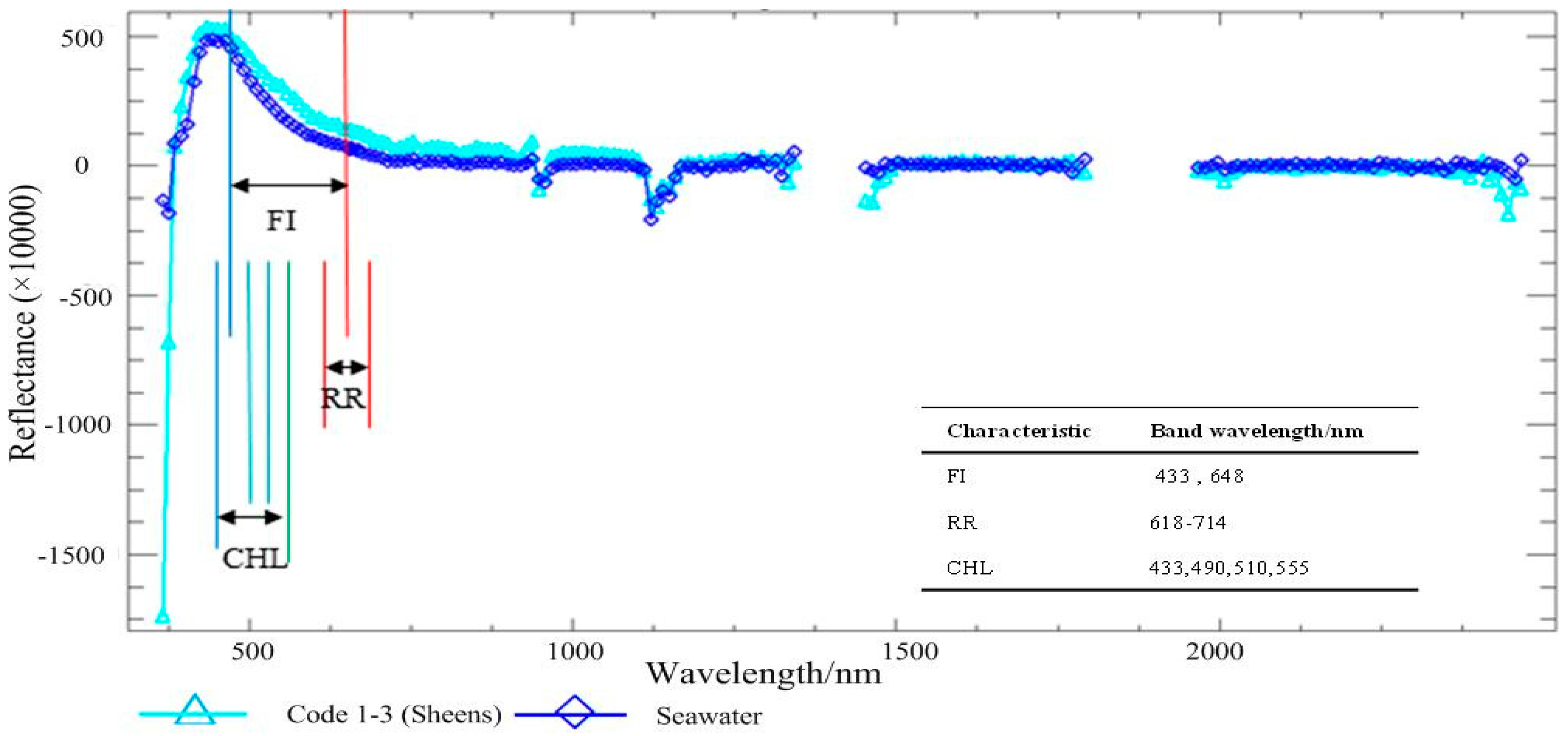

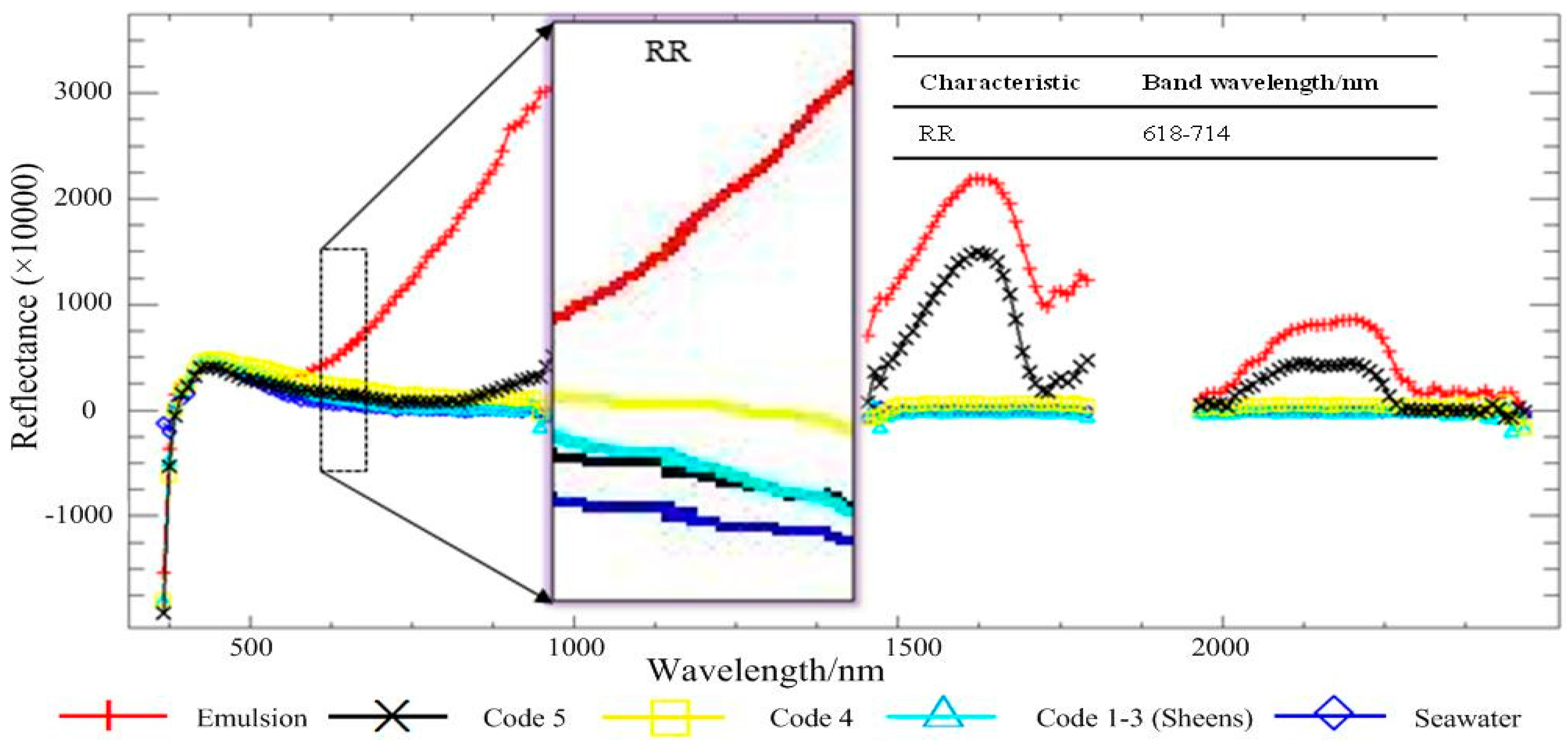
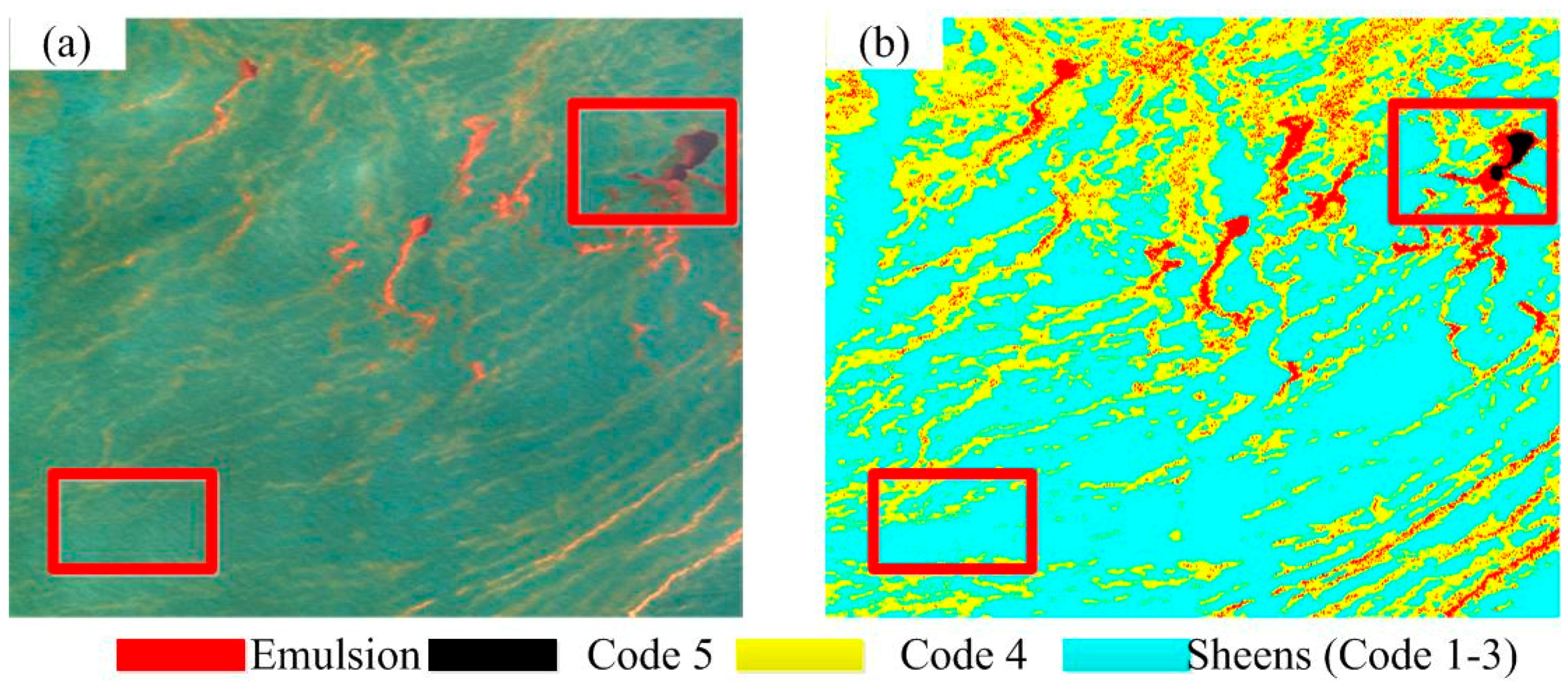
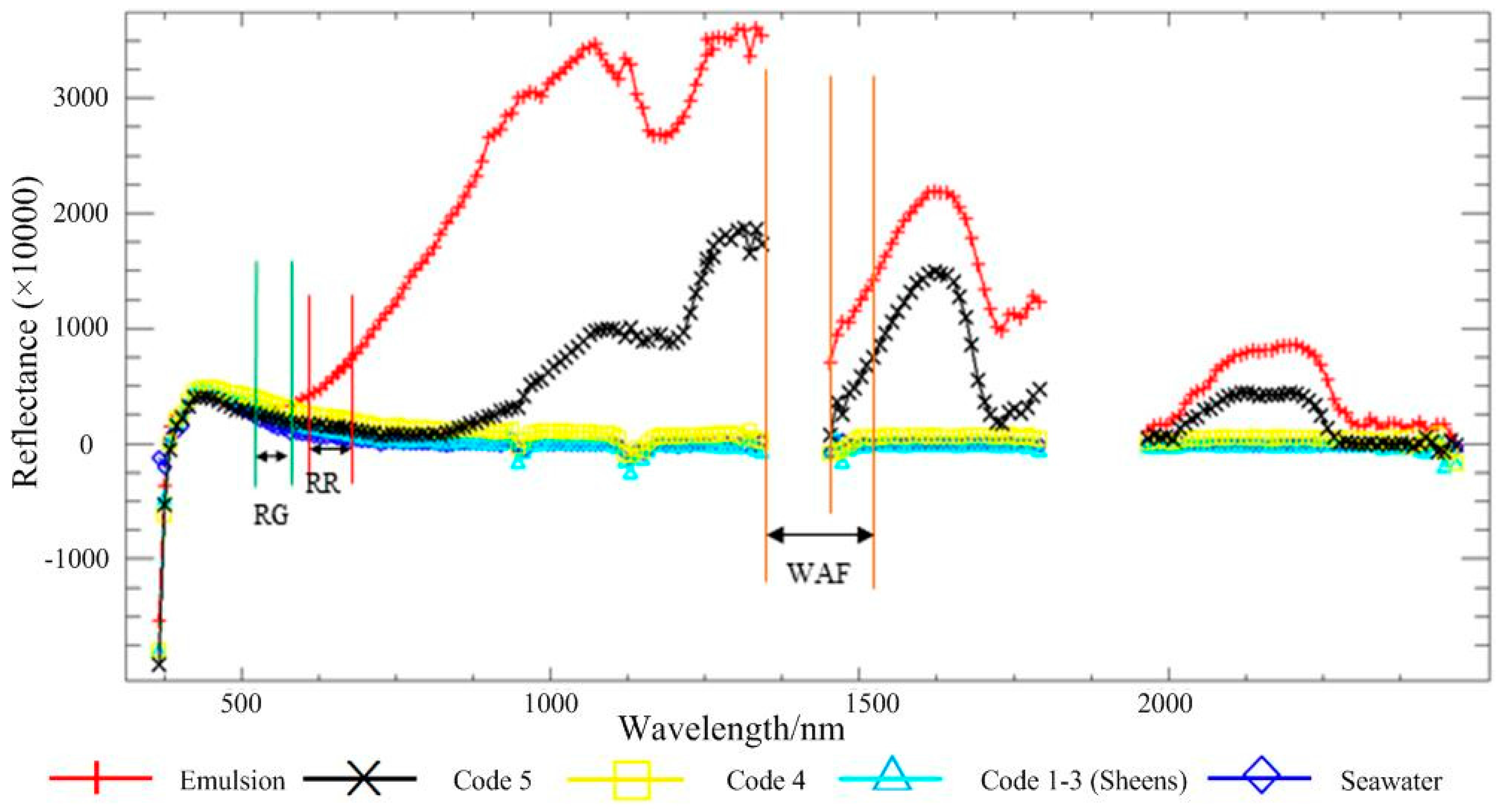
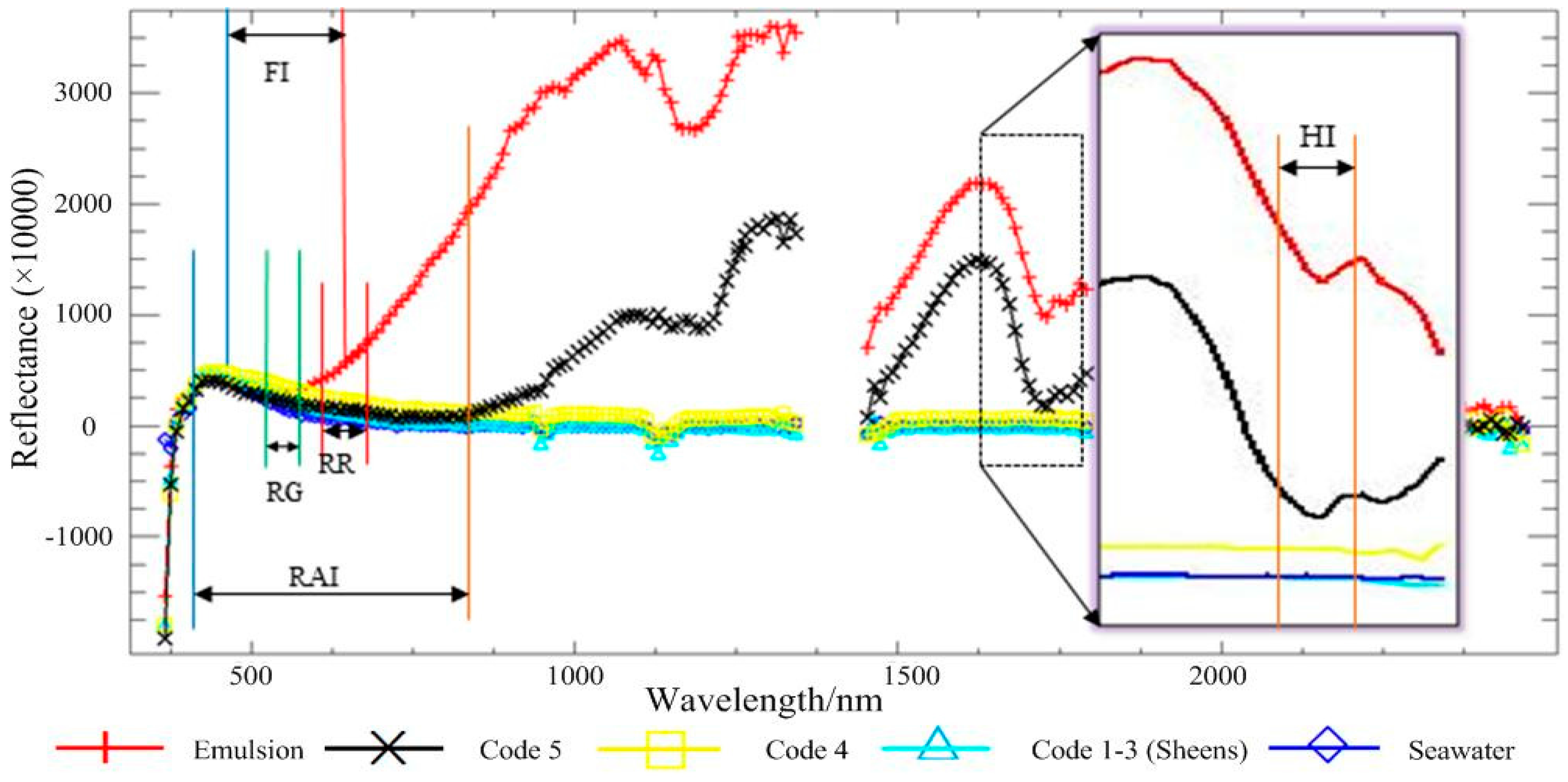
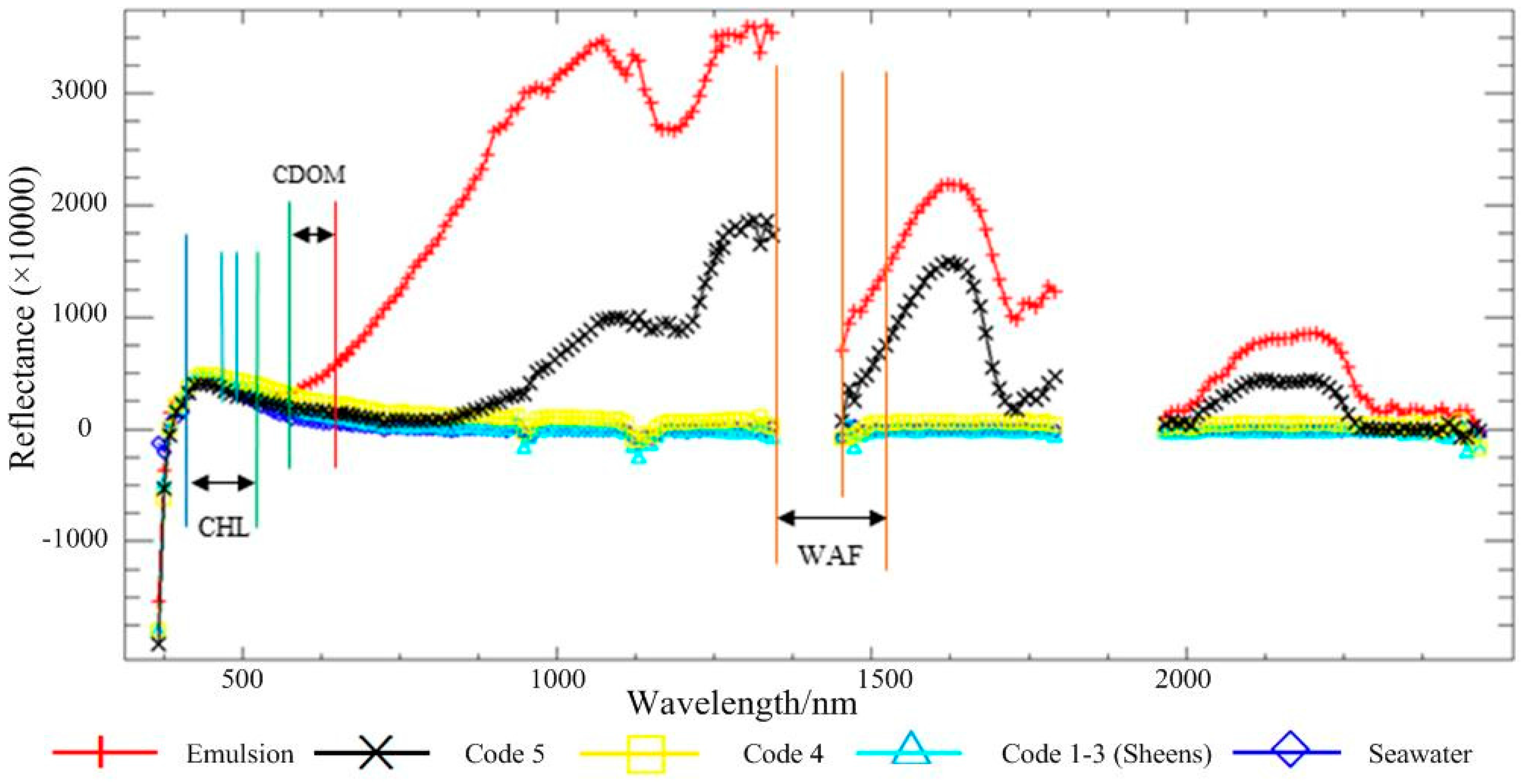
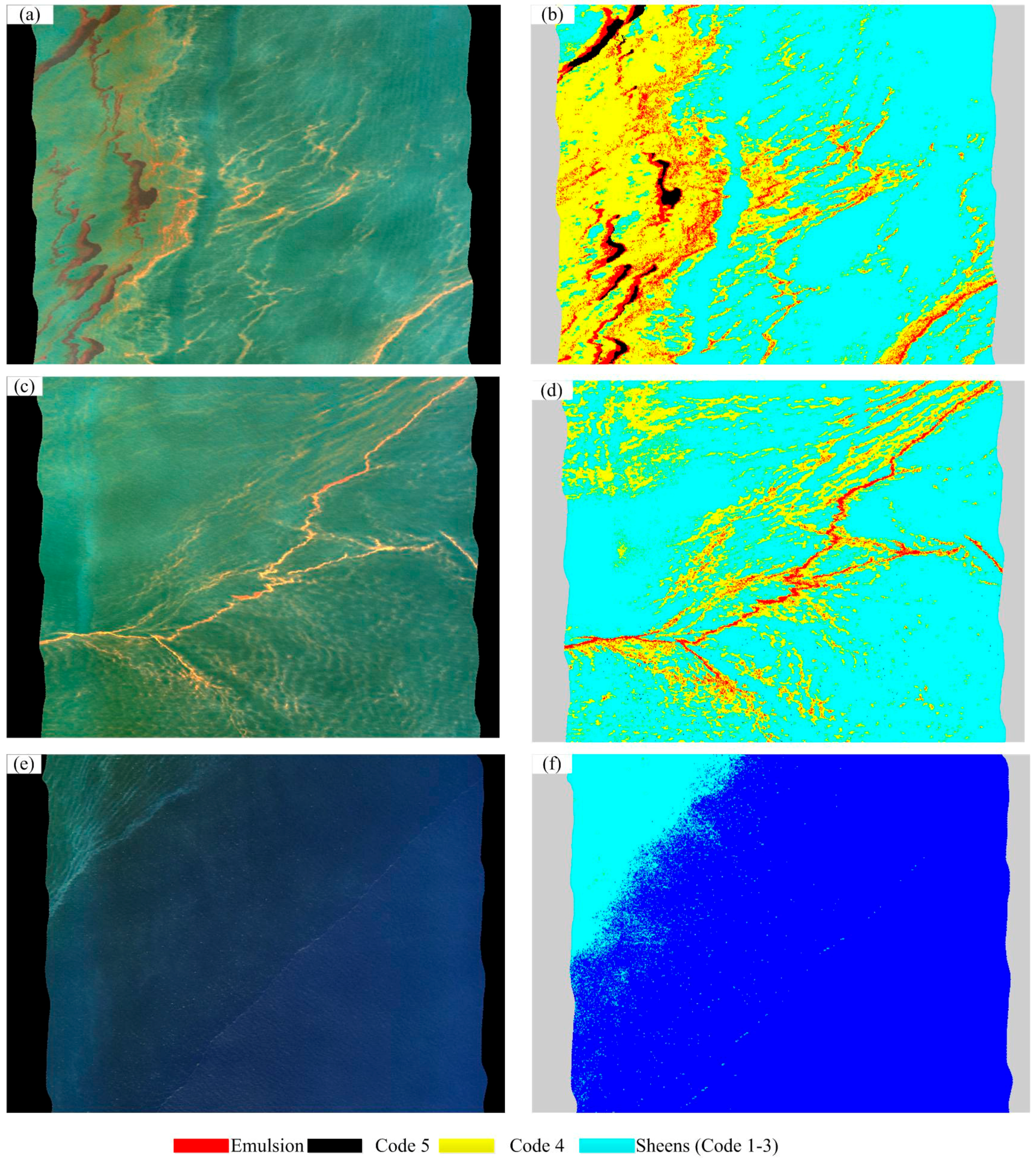

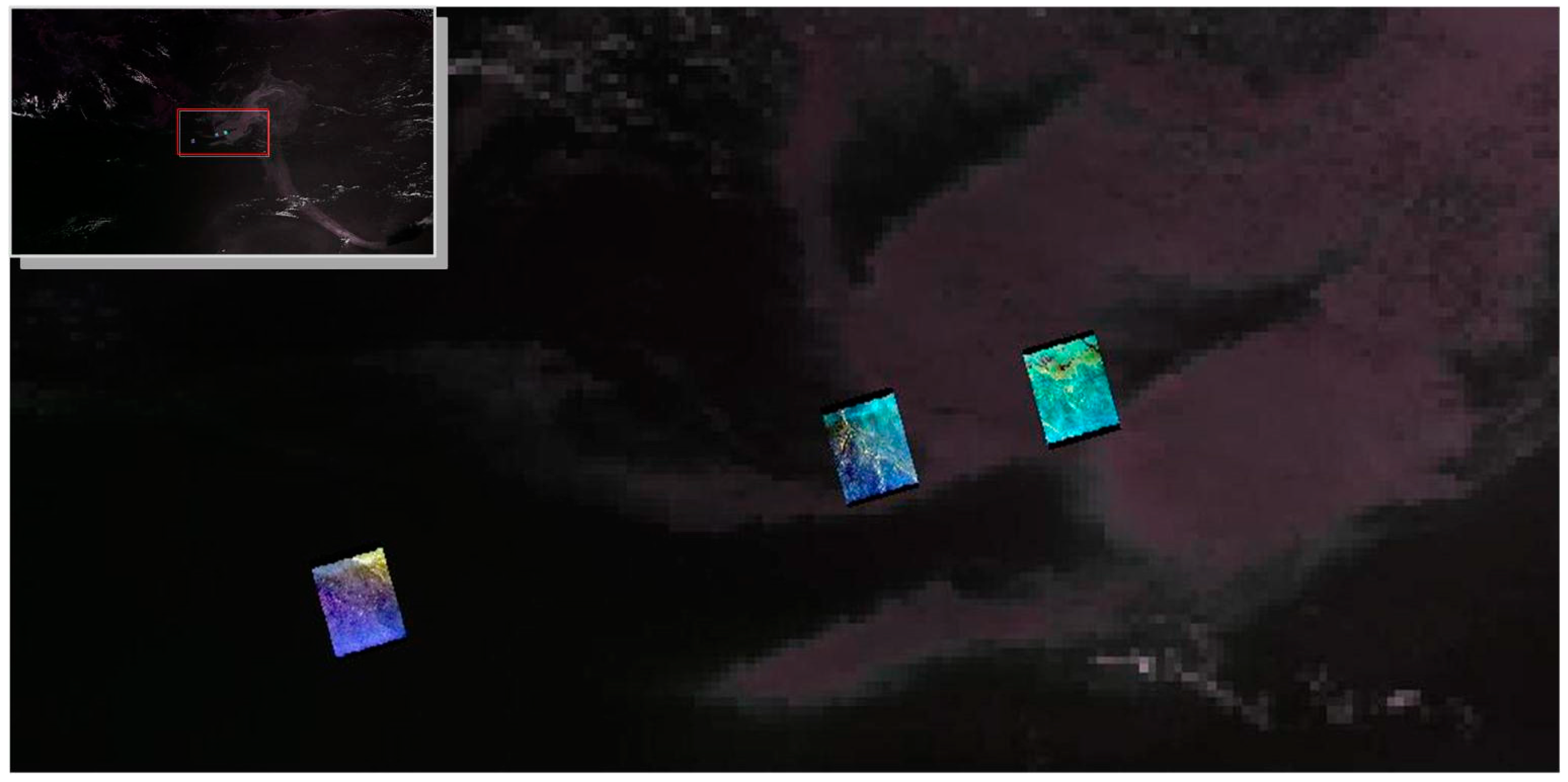
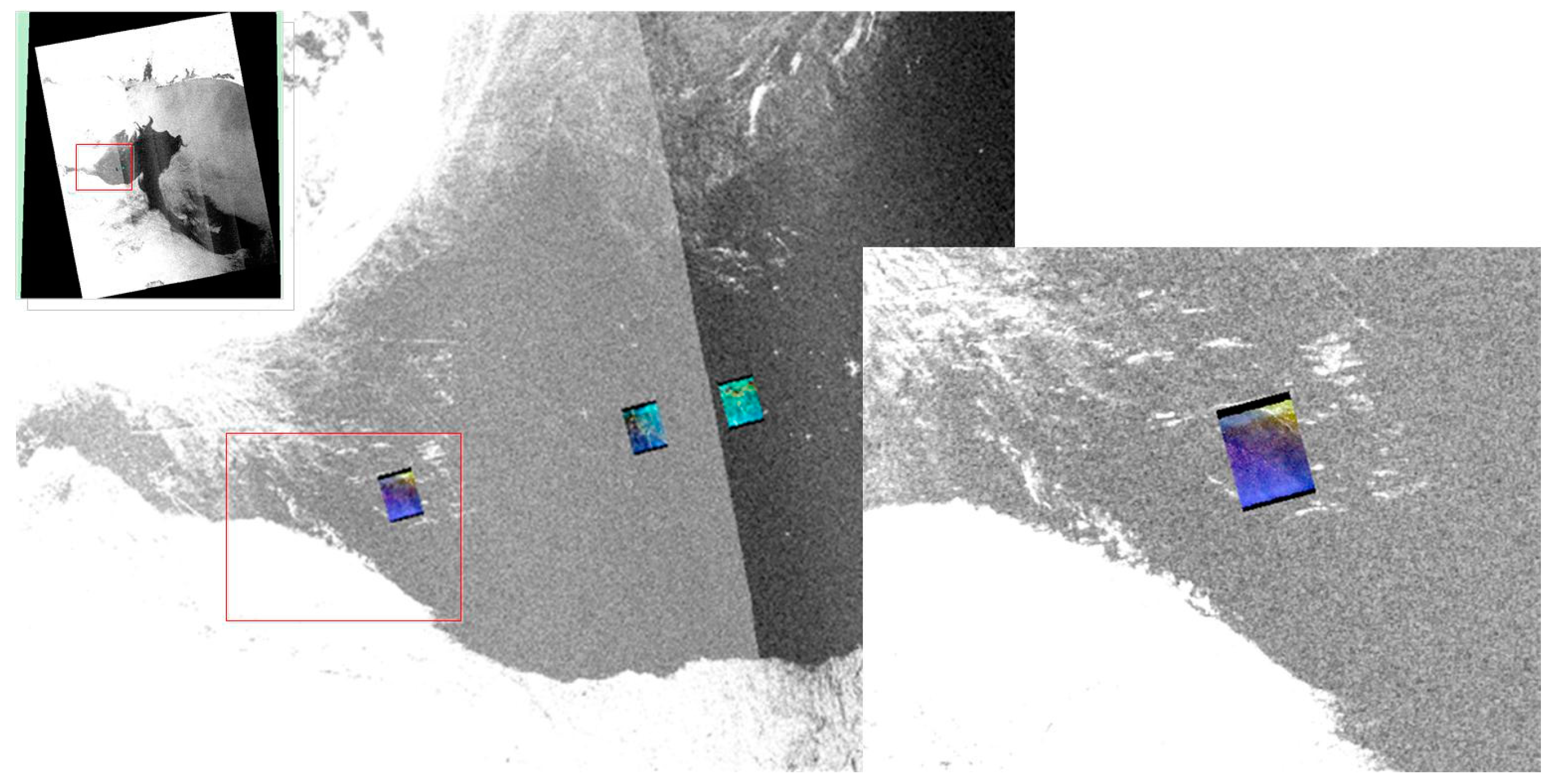

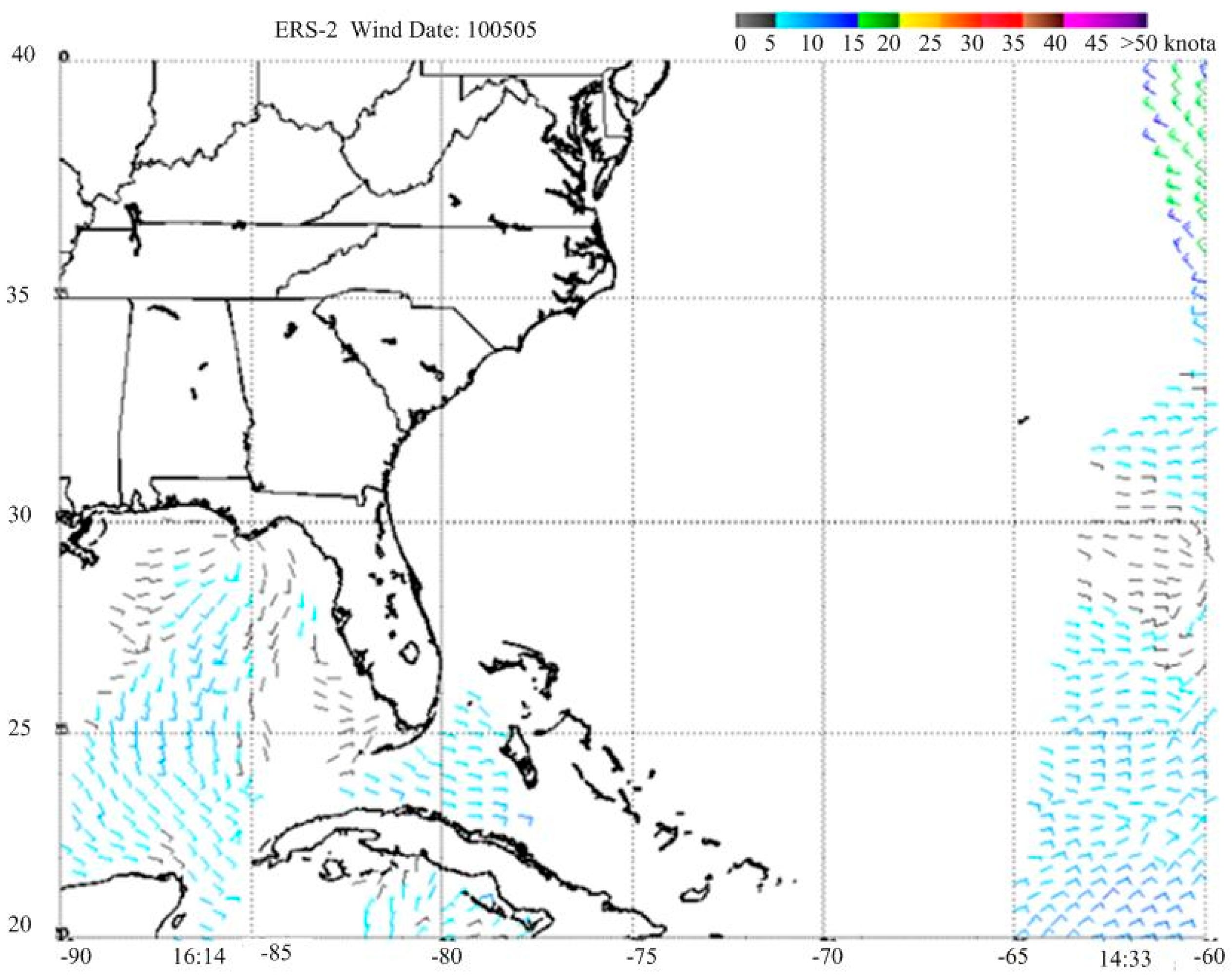
| Thickness | Code | Bonn Agreement Oil Appearance Code | Open Water Oil Identification Job Aid |
|---|---|---|---|
| Thinner | 1 | Sheen (silver/gray) | Silver |
| 2 | Rainbow | Rainbow | |
| 3 | Metallic | Metallic | |
| 4 | Discontinuous true oil color | Transitional dark | |
| 5 | Continuous true oil color | Dark | |
| Thicker | No code | Emulsion | Emulsion |
| Representation | Characteristic | Formula | Reference |
|---|---|---|---|
| Hydrocarbons | Fluorescence Index, FI | [25] | |
| Hydrocarbons | Rotation-Absorption Index, RAI | [25] | |
| Hydrocarbons | Hydrocarbon Index, HI | [26] | |
| Hydrocarbons | Reflectance of Green, RG | [27] | |
| Hydrocarbons | Reflectance of Red, RR | [27] | |
| Seawater | Water Absorption Feature, WAF | [28] | |
| Seawater | Chlorophyll, CHL | [29] | |
| Seawater | Colored Dissolved Organic Matter, CDOM | [30] |
| Characteristics | IS Matrixes | |||||
|---|---|---|---|---|---|---|
| FI | Seawater | Sheens | Code 4 | Code 5 | Emulsions | |
| Seawater | 0 | 0.3368 | 1.2121 | 1.1313 | 1.697 | |
| Sheens | 0.3368 | 0 | 0.4848 | 0.404 | 0.9697 | |
| Code4 | 1.2121 | 0.4848 | 0 | 0 | 0.3232 | |
| Code5 | 1.1313 | 0.404 | 0 | 0 | 0.4848 | |
| Emulsions | 1.697 | 0.9697 | 0.3232 | 0.4848 | 0 | |
| RAI | Seawater | 0 | 0 | 0 | 0 | 0.1347 |
| Sheens | 0 | 0 | 0.0278 | 0.0589 | 0.2443 | |
| Code4 | 0 | 0.0278 | 0 | 0 | 0.1746 | |
| Code5 | 0 | 0.0589 | 0 | 0 | 0 | |
| Emulsions | 0.1347 | 0.2443 | 0.1746 | 0 | 0 | |
| HI | Seawater | 0 | 0 | 0 | 1.2683 | 0 |
| Sheens | 0 | 0 | 0 | 0 | 1.3415 | |
| Code4 | 0 | 0 | 0 | 0 | 1.3182 | |
| Code5 | 1.2683 | 0 | 0 | 0 | 0 | |
| Emulsions | 0 | 1.3415 | 1.3182 | 0 | 0 | |
| RG | Seawater | 0 | 2.3793 | 2.9655 | 0 | 1.3448 |
| Sheens | 2.3793 | 0 | 0 | 2.1379 | 0 | |
| Code4 | 2.9655 | 0 | 0 | 2.7241 | 0 | |
| Code5 | 0 | 2.1379 | 2.7241 | 0 | 1.1034 | |
| Emulsions | 1.3448 | 0 | 0 | 1.1034 | 0 | |
| RR | Seawater | 0 | 0.1038 | 0.5557 | 0.2504 | 1.0443 |
| Sheens | 0.1038 | 0 | 0.3603 | 0.005 | 0.8489 | |
| Code4 | 0.5557 | 0.3603 | 0 | 0.2443 | 0.4031 | |
| Code5 | 0.2504 | 0.005 | 0.2443 | 0 | 0.7328 | |
| Emulsions | 1.0443 | 0.8489 | 0.4031 | 0.7328 | 0 | |
| WAF | Seawater | 0 | 0 | 0 | 1.9371 | 0.53 |
| Sheens | 0 | 0 | 0 | 1.5485 | 0.1413 | |
| Code4 | 0 | 0 | 0 | 1.9247 | 0.5175 | |
| Code5 | 1.9371 | 1.5485 | 1.9247 | 0 | 0 | |
| Emulsions | 0.53 | 0.1413 | 0.5175 | 0 | 0 | |
| CHL | Seawater | 0 | 0.6809 | 0.8298 | 0.5532 | 0.7872 |
| Sheens | 0.6809 | 0 | 0.1064 | 0.1064 | 0.0638 | |
| Code4 | 0.8298 | 0.1064 | 0 | 0.2553 | 0 | |
| Code5 | 0.5532 | 0.1064 | 0.2553 | 0 | 0.2128 | |
| Emulsions | 0.7872 | 0.0638 | 0 | 0.2128 | 0 | |
| CDOM | Seawater | 0 | 0.0043 | 0.0991 | 0.115 | 0.376 |
| Sheens | 0.0043 | 0 | 0.0842 | 0.1001 | 0.3611 | |
| Code4 | 0.0991 | 0.0842 | 0 | 0 | 0.2503 | |
| Code5 | 0.115 | 0.1001 | 0 | 0 | 0.245 | |
| Emulsions | 0.376 | 0.3611 | 0.2503 | 0.245 | 0 | |
© 2018 by the authors. Licensee MDPI, Basel, Switzerland. This article is an open access article distributed under the terms and conditions of the Creative Commons Attribution (CC BY) license (http://creativecommons.org/licenses/by/4.0/).
Share and Cite
Zhao, D.; Cheng, X.; Zhang, H.; Niu, Y.; Qi, Y.; Zhang, H. Evaluation of the Ability of Spectral Indices of Hydrocarbons and Seawater for Identifying Oil Slicks Utilizing Hyperspectral Images. Remote Sens. 2018, 10, 421. https://doi.org/10.3390/rs10030421
Zhao D, Cheng X, Zhang H, Niu Y, Qi Y, Zhang H. Evaluation of the Ability of Spectral Indices of Hydrocarbons and Seawater for Identifying Oil Slicks Utilizing Hyperspectral Images. Remote Sensing. 2018; 10(3):421. https://doi.org/10.3390/rs10030421
Chicago/Turabian StyleZhao, Dong, Xinwen Cheng, Hongping Zhang, Yanfei Niu, Yangyang Qi, and Haitao Zhang. 2018. "Evaluation of the Ability of Spectral Indices of Hydrocarbons and Seawater for Identifying Oil Slicks Utilizing Hyperspectral Images" Remote Sensing 10, no. 3: 421. https://doi.org/10.3390/rs10030421



